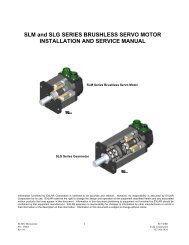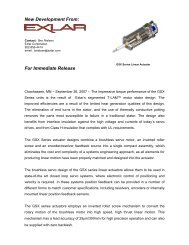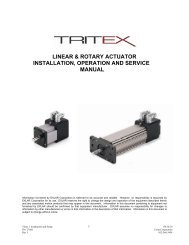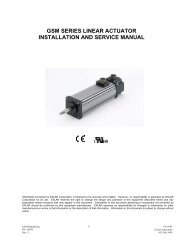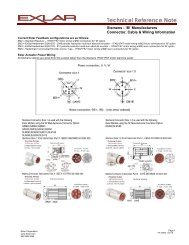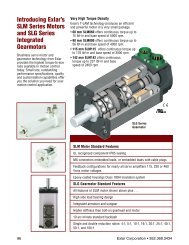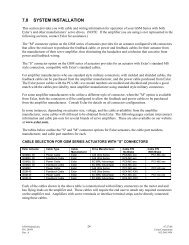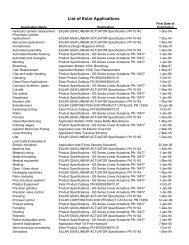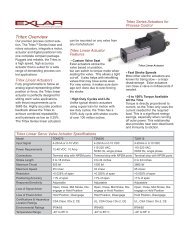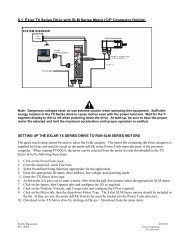You also want an ePaper? Increase the reach of your titles
YUMPU automatically turns print PDFs into web optimized ePapers that Google loves.
Roller Screw Technology<br />
Why Consider Roller<br />
Screw Technology<br />
Designers have five basic choices when it comes to<br />
achieving controlled linear motion. The table on page 3<br />
gives you a quick overview of what general advantages are<br />
associated with each. Because the roller screw technology<br />
common to all <strong>Exlar</strong> linear actuators might not be familiar<br />
to everyone using this catalog, allow us to present a<br />
general overview.<br />
The difference is in the roller screw’s design for transmitting<br />
forces. Multiple threaded helical rollers are assembled in<br />
a planetary arrangement around a threaded shaft (shown<br />
above), which converts a motor’s rotary motion into linear<br />
movement of the shaft or nut.<br />
Roller Screw Basics<br />
A roller screw is a mechanism for converting rotary torque<br />
into linear motion, in a similar manner to acme screws<br />
or ball screws. But, unlike those devices,<br />
roller screws can carry heavy loads for<br />
thousands of hours in the most arduous<br />
conditions. This makes roller screws the ideal choice for<br />
demanding, continuous-duty applications.<br />
Roller Screw vs Hydraulic &<br />
Pneumatic – Comparisons:<br />
In applications where high loads<br />
are anticipated or faster cycling is<br />
desired, <strong>Exlar</strong>’s roller screw actuators<br />
provide an attractive alternative to the<br />
hydraulic or pneumatic options. With<br />
their vastly simplified controls, electromechanical<br />
units using roller screws<br />
have major advantages. They do not<br />
require a complex support system of<br />
valves, pumps, filters and sensors. Thus,<br />
<strong>Exlar</strong> units take up much less space<br />
and deliver extremely long working<br />
lives with virtually no maintenance.<br />
Hydraulic fluid leaks are non-existent.<br />
Noise levels are reduced significantly.<br />
Additionally, the flexibility of computer<br />
programmed positioning can be very<br />
desirable in many applications.<br />
Roller vs Ball Screw<br />
Performance – Comparisons:<br />
Loads and Stiffness: Due to design factors, the<br />
number of contact points in a ball screw is limited<br />
by the ball size. <strong>Exlar</strong>’s planetary roller screw<br />
designs provide many more contact points than<br />
possible on comparably sized ball screws. Because<br />
this number of contact points is greater, roller<br />
screws have higher load carrying capacities, plus<br />
improved stiffness. In practical terms, this means<br />
that typically an <strong>Exlar</strong> roller screw actuator takes up much less space to<br />
meet the designer’s specified load rating.<br />
Travel Life: As you would expect, with their higher load capacities,<br />
roller screws deliver major advantages in working life Usually measured<br />
in “Inches of Travel,” the relative travel lives for roller and ball screws are<br />
displayed on the graph on page 3. As you can see there, in a 2,000 lb.<br />
average load application applied to a 1.2 inch (approximate) screw<br />
diameter with a 0.2 inch (approximate) lead, you can predict that the<br />
roller screw will have an expected service life that is 15 Times Greater.<br />
Speeds: Typical ball screw speeds<br />
are limited to 2000 rpm and less,<br />
due to the interaction of the<br />
balls colliding with each other as<br />
the race rotates. In contrast, the<br />
rollers in a roller screw are fixed in planetary fashion by journals at the<br />
ends of the nut and therefore do not have this limitation. Hence, roller<br />
screws can work at 5000 rpm and higher – producing comparably higher<br />
linear travel rates.<br />
2 9.52.500.6200 | www.exlar.com



